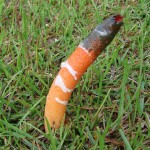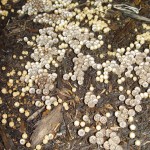Fungus Fest
September 27th, 2011
A side effect of all the rain we’ve had lately is the unusually diverse bloom of fungi all over the landscape.
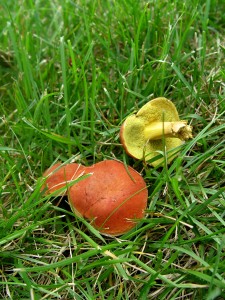
- Most of these common “lawn mushrooms” thrive in wet weather and are non-poisonous. But err on the side of caution because a few poisonous species look like the harmless ones.
I’ve been seeing “puffballs” in the lawn (a.k.a. “dead man’s knuckles”); shelf fungus growing out of dead or dying trees; assorted mushrooms popping up in the mulch, and the one that attracts the most attention, the stinkhorn fungus that reminds people of a certain male appendage (albeit orange in color).
I spent some time talking fungus one day last week with Dr. Gary Emberger, a Messiah College biology professor and one of our area’s pre-eminent fanciers of wood-rotting fungi. Gary teaches a course in mycology at Messiah and has an excellent web site that helps folks ID local mushrooms and such (www.messiah.edu/Oakes/fungi_on_wood.)
The good news is that most of what pops up in our lawns and garden beds is harmless and sometimes even edible.
The bad news is that a few species, if eaten, can make us and our pets sick and in rare instances, even kill. It’s not always easy to tell the difference either because the few worrisome ones look a lot like some of the harmless ones.
The take-away advice is that if you’ve got toddlers or pets – or if toddlers or pets are likely to happen across your yard – it’s best to decapitate and remove the fungal growths. Just bag ‘em and toss ‘em. They’re not toxic to the touch… just when they’re eaten.
You’re not going to prevent them or stop them anyway, says Emberger, and using fungicides to kill lawn mushrooms and the like would seriously threaten the population of beneficial microorganisms (the majority of microbial life).
Below are a few of the most common landscape fungi in central Pa. I can’t emphasize enough to get a definitive ID of anything before you even think about eating it. Otherwise, if intentional or unintentional eating is a non-issue, enjoy the show.
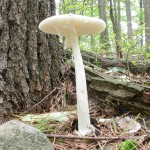
The "destroying angel" -- one of the most poisonous (i.e. deadly) mushrooms. (Credit: Dr. Gary Emberger)
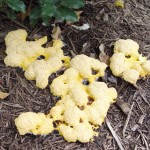
Slime mold, a.k.a. "dog vomit fungus,' starts as a yellowish blob in mulch and dries to a black powder. Not poisonsous.










